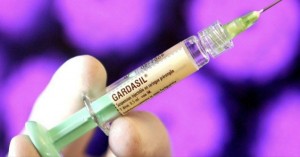Photo Found Here
After our discussion of the Gardasil vaccine in class on Thursday, November 3, I could not stop thinking about how common it is for people to contract HPV. The statistics we heard about in class were absolutely appalling and disturbing to me. I thought of a lot of questions:
+Is HPV the main cause of cervical cancer? My hypothesis: the main cause of cervical cancer is HPV.
+Is HPV more common in women or men? I was a bit confused after class–I want to know which sex is more likely to have HPV and why. My hypothesis is that women are more likely to contract or have HPV.
+How many strains of HPV does Gardasil protect against? I am unfamiliar with specific details about the Gardasil vaccine.
According to a study Journal of the National Cancer Institute, there are over twenty different strains of HPV that can cause cervical cancer. Gathered from over 22 countries, 1000 different cancerous specimens were tested, where 25 different cancer-causing strains of HPV were detected.
This is an observational study because HPV was not randomly allocated to participants; each of the people who sent in cancerous specimens already had HPV, and the scientists were examining causes.
HPV was found in 93% of the cancerous tumors and only the remaining 7% of cancerous tumors of the cervix did not contain some form of HPV. This is a number even higher than I was expecting. Different strains of HPV were more common in specific geographical locations, for example, HPV 45 was found mostly in Africa, according to the study. The study concludes by indicating that HPV is the leading cause of cervical cancer.
It is unlikely that this type of study suffers from the file drawer problem or the Texas sharpshooter problem.
According to Epidemiology of Genital Human Papillomavirus Infection in the American Journal of Medicine, the risk of cervical cancer was 8.6/ 100,000 people between 1988 and 1992. HPV 16 seemed to cause cervical cancer the most. The FDA shows statistics that cervical cancer is among the most common cancers of women and is the cause of over two hundred thousand deaths annually. The FDA also states that, among sexually active Americans, HPV is the most common STI.
In that journal it was also found that the most likely people to be infected with HPV are (sexually active) women under 25 years of age.
According to Maura L. Gillison, MD, PhD , Oral HPV is actually more prevalent in males than females. Approximately 7% of males and approximately 3% of females in the study were found to have HPV. A study like this likely does not suffer from the Texas Sharpshooter Problem or the File Drawer Problem.
Gardasil is a vaccine that is supposed to protect against HPV. How many strains? And how effective is it?
In the poll in class, we saw that approximately 60% of females had the vaccine (and the males of class seemed reluctant to respond for some reason).
The FDA article mentioned above states that Gardasil prevents HPV 16 and 18, and as seen in the journal study, HPV 16 is most likely to cause cervical cancer (70% of cervical cancers!). Gardasil also protects against two other strains that cause the most amount of genital warts (90%!). Gardasil only protects against these specific strains of HPV and does not prevent any other strains. So, people still can get different types of HPV and still get cervical cancer if they get the shots. However, it is definitely worth it, in my opinion, to get the Gardasil shot. The FDA discusses studies where about 100% of Gardasil-receivers were protected against symptoms of HPV including cervical-cancer-causing lesions and genital warts.
So, in conclusion, studies do indicate that HPV is the main cause of cervical cancer. And studies also show that Gardasil is effective. It is quite scary that so many people get infected with HPV in their lifetimes. It is so common, and it can have serious consequences.


Very good article Molly! I really liked how you tried to link a lot of definitons and class discussions. HPV is something I never really worried about as a male. Likewise, as a young aged student I find myself thinking that nothing will ever happen to me. Obviously, as we learned in class, this is very likely to contract. My question is, did the studies find a high enough correlation that you can find causation? Or is it possible that we have another scenario with chance that is a false positive? Obviously, multiple studies have been shown this is linked, but the possibility still stands.